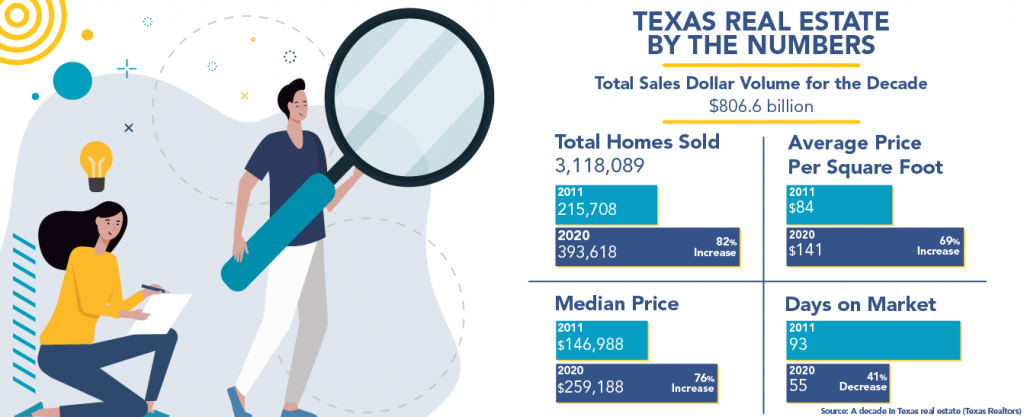What a decade it’s been for the Texas real estate market! Its growth is evident to the expert – and not-so-much – eye, but now we have some numbers to be astonished by. According to the report “A decade in Texas real estate” published by Texas Realtors, the market experienced a 76% increase in median home prices from 2011 to 2020. And, over the last ten years, 3,118,089 homes were sold, reaching a total sales dollar volume of $806.6 billion!
Let’s take a moment to catch our breath. Are you ok? Good, let’s keep diving into this report then. Statewide, the growth in median home prices means a $112,200 difference between 2011 (when properties were sold by 215,708 on average) and 2020, when that number rose to 393,618. Furthermore, the average price per square foot experienced a 69% increase, from $84 to $141.

“We’ve had a dynamic real estate market in Texas over the past decade,” said Marvin Jolly, chairman of Texas Realtors, in a statement. “Some of the factors that have affected real estate transactions and property ownership include significant population growth, natural disasters big and small, new home technologies, and, of course, the pandemic,” he explained.
Until now, every number mentioned experienced steady growth over the decade, except for the number of days on the market. The report shows that this is the only indicator that saw a decrease. Back in 2011, homes stayed on the market for 93 days, on average. However, in 2020 they only remained there for 55 days. This particular behavior doesn’t come as a surprise if we consider that the U.S., in general, has experienced low inventory for quite a while now.
Fortunately, the report goes deeper in the analysis and provides data at a metro level. Overall, three-quarters of homes sold in the past decade were located in the state’s four largest metro areas (Austin-Round Rock, Dallas-Fort Worth-Arlington, Houston-The Woodlands-Sugarland, San Antonio-New Braunfels), with Dallas-Fort Worth-Arlington topping the list at 923,528 homes sold.
Regarding the total amount of homes sold, San Antonio took the lead with a 114% increase, followed by Austin (94%), Dallas (79%), and Houston (71%). On the other hand, if we look at the median home price, Dallas experienced the most significant increase (94%), followed by Austin (82%), Houston (68%), and San Antonio (65%). And lastly, both Austin and Dallas are the hottest real estate markets in Texas, where properties remained on the market for 45 days in 2020. In Houston, they stayed a bit more (54), and in San Antonio, it took longer to complete transactions (57 days).
“The Texas housing market thrived during the last ten years. It expanded at a record pace, achieving consistent home sales growth each year and strong home price growth during the decade,” assured Luis Torres, a Ph.D. research economist with the Texas Real Estate Research Center at Texas A&M University.
The success is even more significant if we take a look at this year’s numbers. In April, properties spent 43 days on average in the market before a purchase – considerably less time than in 2020. And that number goes down way more in Austin, where the median is only 17 days. Moreover, in 2021 Q1, virtually every metro area in the U.S. experienced year-over-year rises. Austin, in particular, is in the top 5 areas with the highest price increases.
For this reason, if you’re a real estate investor, it’s critical to have access to the best information you can find. Luckily for you, we have the best data in Texas! We can provide you with off market properties that haven’t hit the market, so you have more time to work with homeowners. Subscribe now and forget about rushing your negotiations!
Disclaimer: The blog articles are intended for educational and informational purposes only. Nothing in the content is designed to be legal or financial advice.
Sources:
- https://www.texasrealestate.com/wp-content/uploads/DecadeReport.pdf
- https://www.texasrealestate.com/about-us/newsroom/news-releases/report-more-than-3m-texas-homes-sold-112k-increase-in-median-price-from-2011-to-2020/





